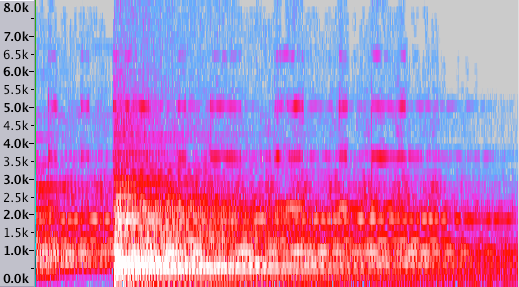Here’s the Reddit thread where this started. The short version is: /u/Takfloyd pointed out that, when you first enter a Divine Beast (and up until you activate one of its terminals), for example Vah Medoh, the music includes Morse code, beeping an SOS.
Then /u/TonesBalones and /u/Dragonaichu point out that, while there’s definitely an SOS in the left channel, the right channel plays different Morse: . . – . – – . .
So what does that mean?
First off: Whenever one is looking for a hidden message in an obscure part of a video game, there is a danger that one is wasting one’s time and acting like a crazy person. It is wise to approach such hypotheses with a certain measure of skepticism—but to cling to that skepticism blindly is to inhabit a world without magic, to live a life without Easter eggs.
It’s clear to anyone who takes out their left earbud that there’s a repeating sequence of beeps. The skeptical interpretation would be that the sequence is random and the composer did not encode anything, but anyone who studies the Breath of the Wild soundtrack knows that Manaka Kataoka is basically a huge nerd who saw every composition as an opportunity to include some bit of cleverness. The coolest example is the music at the ruined Temple of Time, which interprets the Song of Time so slowly and disjointedly that it sounds more like Zelda’s Lullabye.
So it’s not a sure thing, but it’s not a totally crazy idea to think that Kataoka intended for the other series of beeps in the Divine Beasts to mean something. The problem is, you can’t really tell where the letter divisions in this string are. Listen:
That’s not how you transmit Morse code! You’re supposed to have a dash-length pause between letters. The pauses here are basically the same, as you can see in this spectogram:

If you zoom in really close in Audacity, you can see that some of the pauses are slightly longer, but we’re talking about a difference of about 70 milliseconds. Probably not significant. But just by looking closely at this spectogram you can also see that /u/TonesBalones and /u/Dragonaichu got one thing wrong: The final signal is a dash, not a dot. So we really need a translation of . . – . – – . -, not that that makes things any easier.
There are seven places in an eight-tone sequence where you could insert letter breaks. That means there are 2^7 possible divisions of this sequence. However, not all of them are valid Morse code: Morse letters are only up to 4 signals long; the digits are 5 signals, and some of the prosigns are longer. So some of the 128 interpretations are invalid. The divisions that do make Morse sense are as follows:
FQ FGT FMA FMET FTK FTNT FTTA FTTET UPT UWA UWET UAK UANT UATA UATET UEQ UEGT UEMA UEMET UETK UETNT UETTA UETTET I<KN>T IYA IYET IKK IKNT IKTA IKTET INQ INGT INMA INMET INTK INTNT INTTA INTTET ITPT ITWA ITWET ITAK ITANT ITATA ITATET ITEQ ITEGT ITEMA ITEMET ITETK ITETNT ITETTA ITETTET E<AA>K E<AA>NT E<AA>TA E<AA>TET ERQ ERGT ERMA ERMET ERTK ERTNT ERTTA ERTTET EAPT EAWA EAWET EAAK EAANT EAATA EAATET EAEQ EAEGT EAEMA EAEMET EAETK EAETNT EAETTA EAETTET EE<KN>T EEYA EEYET EEKK EEKNT EEKTA EEKTET EENQ EENGT EENMA EENMET EENTK EENTNT EENTTA EENTTET EETPT EETWA EETWET EETAK EETANT EETATA EETATET EETEQ EETEGT EETEMA EETEMET EETETK EETETNT EETETTA EETETTET
(<AA> and <KN> are those prosign thingies.) None of these look like cool Easter eggs to me, but maybe I’m not seeing it. Maybe you should go back and look through them again for me.
However, there are some other possible interpretations of the signal. Wabun is a Japanese version of Morse, and I think Kataoka would be as likely to use Wabun as Morse for these purposes. The problem is, Wabun has more characters to encode, so there are a lot more possible interpretations for this string. The other problem is, I don’t know Japanese.
But if you know Japanese, and you want to see whether the signal translates to anything, you shouldn’t have to go through the trouble of parsing every possible letter-division of the signal, so I’ve done that for you. Here they are. I do know enough about Japanese to know that some of these “words” are phonotactically or orthographically impossible, especially those that start out with a dakuten, but I’ve included them here anyway. Lines with a ### are technically not valid Wabun; the “###” indicates a string that doesn’t encode anything. So you can ignore those lines.
###mu ###i ###hemu miwa mitamu mimui mimuhemu chine chirimu chiyoi chiyohemu chimuwa chimutamu chimumui chimumuhemu uu utsumu uyai uyahemu uiwa uitamu uimui uimuhemu uhene uherimu uheyoi uheyohemu uhemuwa uhemutamu uhemumui uhemumuhemu ゛### ゛rumu ゛kei ゛kehemu ゛wawa ゛watamu ゛wamui ゛wamuhemu ゛tane ゛tarimu ゛tayoi ゛tayohemu ゛tamuwa ゛tamutamu ゛tamumui ゛tamumuhemu ゛muu ゛mutsumu ゛muyai ゛muyahemu ゛muiwa ゛muitamu ゛muimui ゛muimuhemu ゛muhene ゛muherimu ゛muheyoi ゛muheyohemu ゛muhemuwa ゛muhemutamu ゛muhemumui ゛muhemumuhemu he### he###mu hetei hetehemu herowa herotamu heromui heromuhemu henane henarimu henayoi henayohemu henamuwa henamutamu henamumui henamumuhemu heii heitsumu heiyai heiyahemu heiiwa heiitamu heiimui heiimuhemu heihene heiherimu heiheyoi heiheyohemu heihemuwa heihemutamu heihemumui heihemumuhemu hehe### heherumu hehekei hehekehemu hehewawa hehewatamu hehewamui hehewamuhemu hehetane hehetarimu hehetayoi hehetayohemu hehetamuwa hehetamutamu hehetamumui hehetamumuhemu hehemuu hehemutsumu hehemuyai hehemuyahemu hehemuiwa hehemuitamu hehemuimui hehemuimuhemu hehemuhene hehemuherimu hehemuheyoi hehemuheyohemu hehemuhemuwa hehemuhemutamu hehemuhemumui hehemuhemumuhemu
If the right-channel beeping in the Divine Beasts means anything, it’s probably a message that appears in one of the lists above. I can’t find it. Maybe it’s not there! But maybe I’m just not clever enough to see it. But maybe it’s not there. Belief or disbelief rests with you.